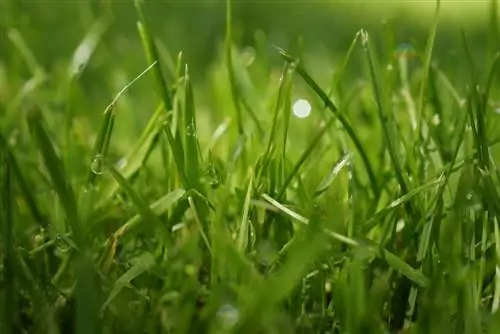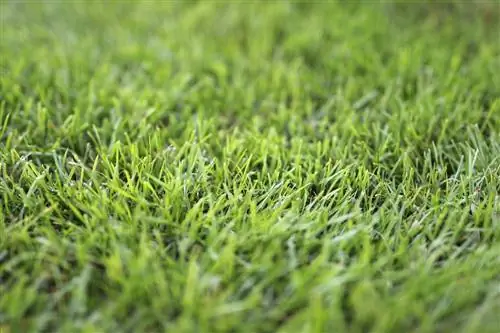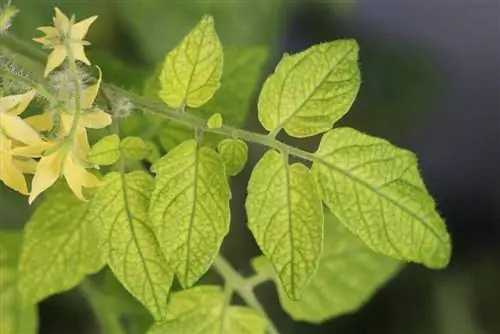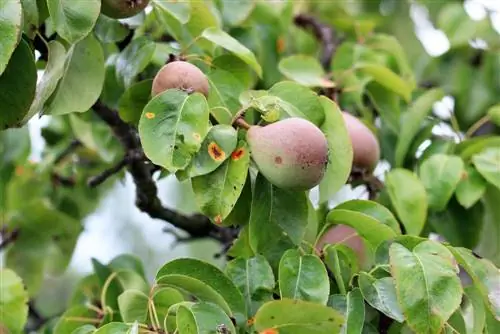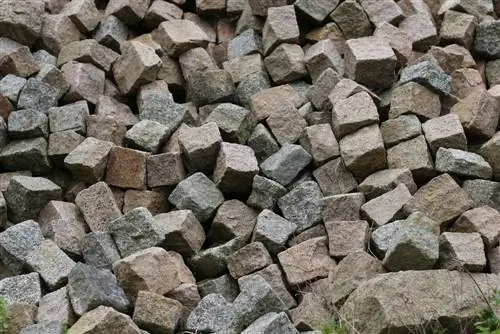- Author admin [email protected].
- Public 2023-12-17 03:39.
- Last modified 2025-01-24 12:45.
Iron fertilizer is particularly beneficial for the lawn and can displace moss. Unfortunately, it also creates unsightly orange, brown or even black spots on various surfaces. After spreading, these appear on the lawn itself and primarily on stones, such as paving slabs or terrace tiles. We explain here how these rust stains can be removed and avoided in advance.
Causes
If the lawn turns black in places after applying iron fertilizer, this is completely normal and indicates that the fertilizer has a desired effect. Because the black spots are dead moss. However, if the stains appear on stones and sidewalks, it is rust. The iron oxidizes and rust spots form, just like with pipes or metal. These are usually extremely unsightly but not dangerous or harmful to the material.
Stains on the lawn
Black discoloration on the lawn can be easily remedied. If the moss is thoroughly removed, the black spots will disappear. If the moss spreads a lot, spots and then gaps in the lawn can become quite large. It is therefore advisable to reseed if necessary. An alternative to using iron fertilizer can be using a scarifier. This also reduces moss and weeds in the lawn.
If the lawn has orange to brown spots, these are iron fertilizer residues. This oxidizes in air. This means it combines with oxygen and rust forms. This can be remedied:
- use smaller amounts of iron fertilizer
- to distribute the iron fertilizer evenly
- Watering the lawn evenly and repeatedly after fertilization
It is also beneficial to apply the iron fertilizer before it rains. In this way it is distributed better in the soil. Any stains that have already formed are also “washed away”. If rain is not expected, the lawn should be generously sprinkled. However, several waterings may be necessary until the stains disappear.
Stains on stones
Rust stains on stones are particularly noticeable and annoying. They occur when the iron fertilizer accidentally falls onto paving slabs or is carried there on the soles of shoes from the lawn. They also pose a challenge when it comes to removing them. How this needs to be done depends on the type of stone and its properties:
Smooth and sealed stones or tiles
Ceramic materials and sealed or painted surfaces can be relatively easily removed from rust stains. If the stain is still fresh, it can simply be scrubbed with water and a brush. Ascorbic acid, soft soap or household cleaners can be used to help. If the rust stains cannot be removed in this way, a special tile cleaner can be used. Sanitary or bathroom cleaners are also suitable for this.

Acid-sensitive stones or soft rock
If rust stains are found on marble, terrazzo, cast stone, travertine and limestone, they are difficult to remove with commercially available cleaners. Home remedies should also not be used on this as they can attack and damage the surface. This is especially true for ascorbic acid, better known as vitamin C powder. This is often recommended against rust stains on stones, but can cause stains and cracks on acid-sensitive stones. It is better to use a rust remover or special cleaner for soft stone or acid-sensitive types of stone.
Acid-insensitive stones and hard stones
Acid-resistant stones such as granite, quartz-bound sandstone and some hard stones are resistant. This makes cleaning a little easier. Ascorbic acid can be used as a home remedy. The powder is applied to the moistened stain and left to act for a few minutes. The stain is then scrubbed with a brush and the stone is rinsed thoroughly. If you want to be on the safe side, use a special rust remover for acid-resistant stones or hard rock.
Tip:
Ascorbic acid is available very inexpensively in pharmacies, drugstores and sometimes even in supermarkets. It is often listed as vitamin C powder. Alternatively, citric acid can also be used. This is available, among other things, for descaling washing machines, kettles or coffee machines.
Mechanical removal
If you don't want to use a chemical cleaning agent straight away, you can first try out mechanical cleaning options. Light rust stains can occasionally be removed with water and a brush. For stronger and larger rust stains, however, we recommend a high-pressure cleaner that only works with water. A sandblaster can also be useful.
In both cases, care must be taken to ensure that the stones do not react sensitively to pressure or even show damage such as cracks or breaks. The pressure from the high-pressure cleaner or sandblaster could increase this damage. The use of chemical agents is therefore more advisable for damaged areas or sensitive stones. If these are to be applied and used over large areas, an electric scrubber can be used. This significantly reduces the amount of effort required.
Stone type
One of the most common problems in properly removing rust stains from stone is choosing the right product. This again depends on what type of stone it is. This is exactly where the challenge lies, because many people don't know what stone the pavement slabs or terrace tiles are made of.
There are several ways to find out:
Comparisons in hardware stores
Hardware stores often carry a large selection of stones and paving slabs. Comparing and finding the appropriate type of stone is therefore usually easy.
Image search on the Internet
Grain, surface and descriptions of different types of stone can be found on the Internet and also allow for easy comparison.
Inquiry in the stone trade
Experts can determine their type based on photos of the stones. Hardware stores or stone shops are the right places to go.
Prevent rust stains
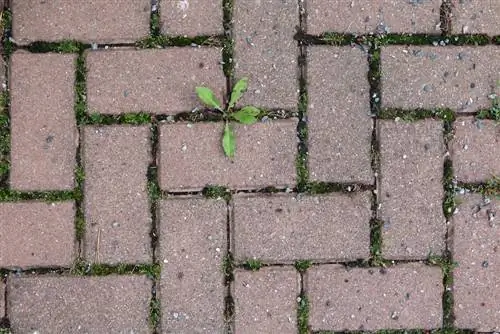
Rust stains caused by iron fertilizers are sometimes difficult to remove and, depending on the material, completely removing them is very time-consuming. However, it is much easier to prevent stains. The following points are important:
economical use
If iron fertilizer is used too generously, it often spreads not only on the lawn - but also in the surrounding area. It is better to use it sparingly and sprinkle it just over the lawn. This direct application reduces the risk of the iron fertilizer being spread into the surrounding area by a gust of wind.
targeted distribution
When spreading fertilizer, it will almost inevitably happen that the iron fertilizer doesn't just end up on the lawn. This is particularly difficult when treating the edges. It becomes easier if a spreader is used. These devices are inexpensive, easy to use and also help to distribute the fertilizer economically and evenly.
Water
If the iron fertilizer is not applied shortly before a rainfall, the lawn should be watered specifically. This means the fertilizer spreads more quickly and is absorbed into the soil, reducing the risk of carrying it on shoes or paws onto the sidewalks.
No entry allowed
To prevent the iron fertilizer from being carried over and smeared, the lawn should not be walked on in the first few days after the iron fertilizer has been applied. Pets should also not be allowed to walk or play on it at first.
Changing shoes
During application, it is almost impossible to avoid stepping into the iron fertilizer yourself. It is therefore advisable not to walk on paving slabs afterwards. Instead, you should change your shoes straight away to avoid spreading the fertilizer on the stones. It is also possible to put disposable covers or plastic bags over your shoes and remove them when leaving the lawn.

